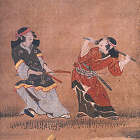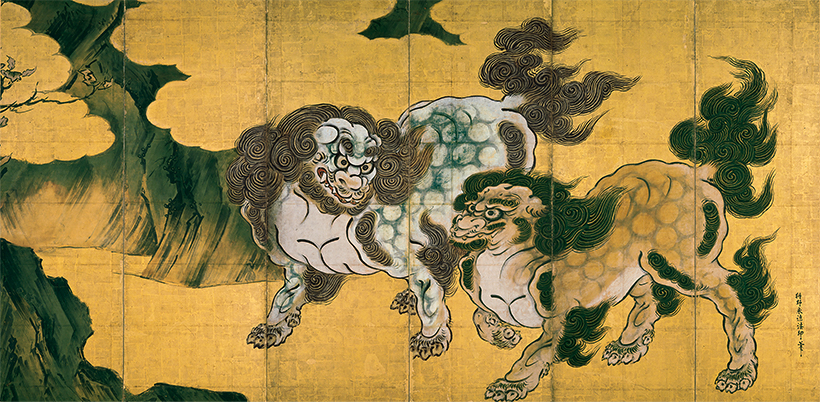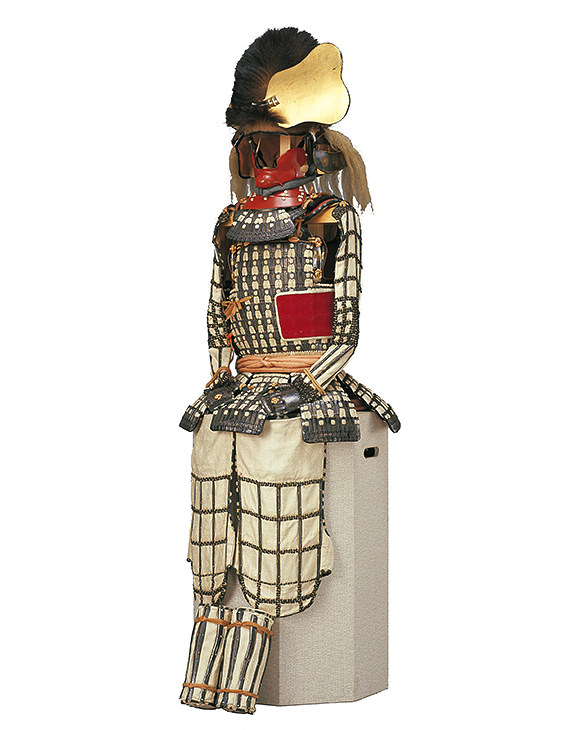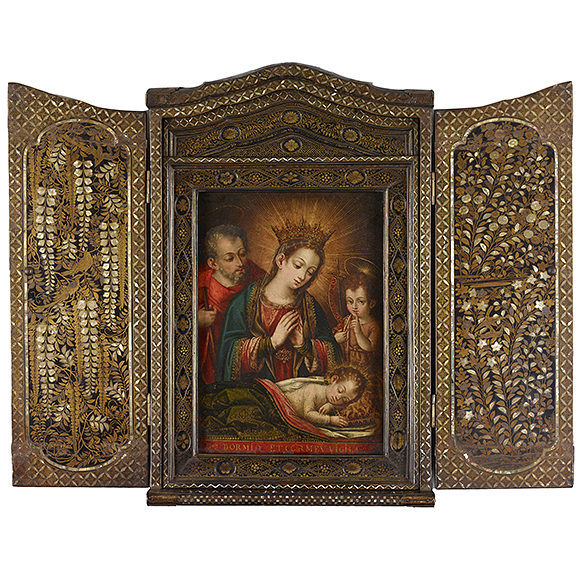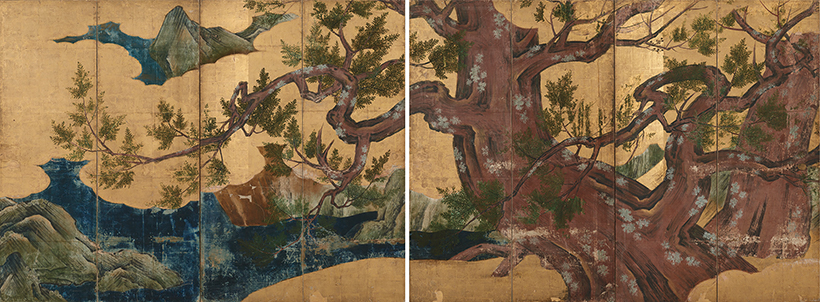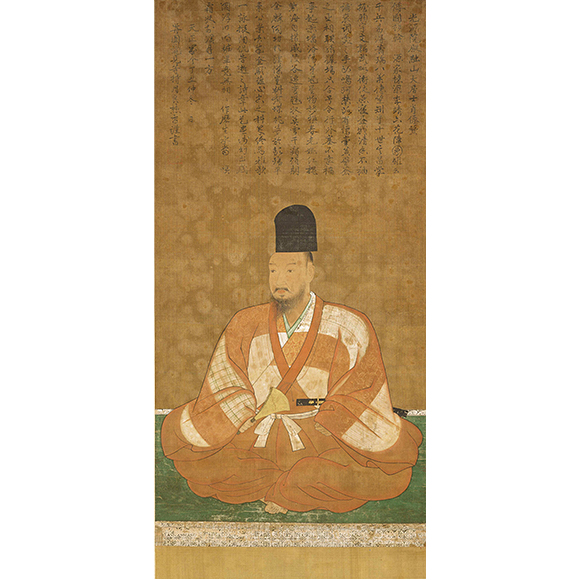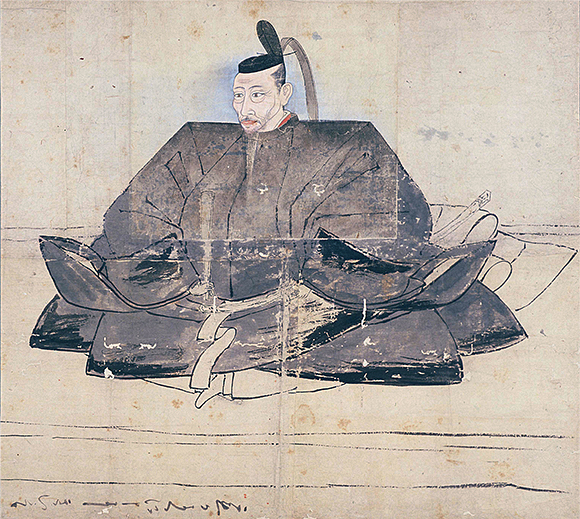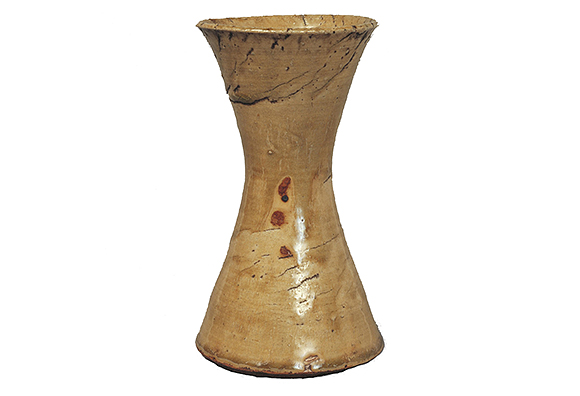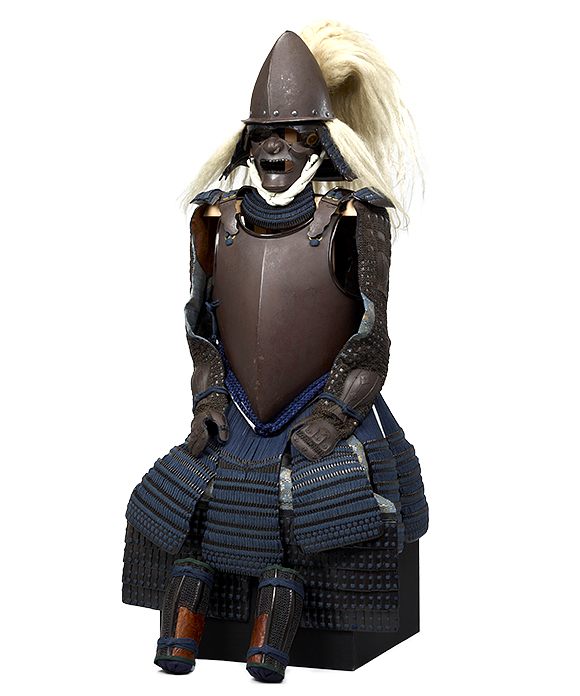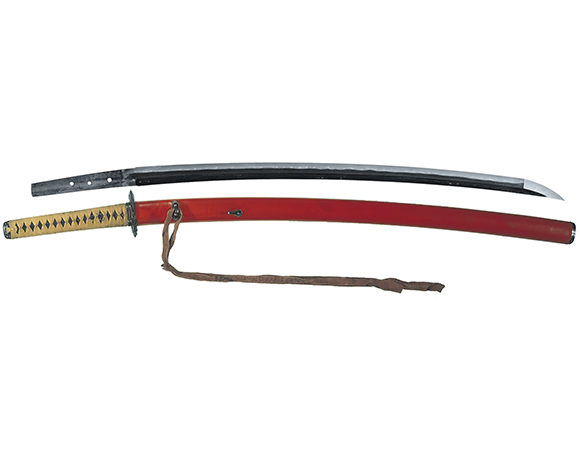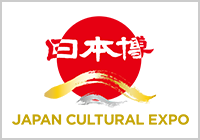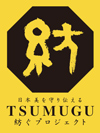Highlights of the Exhibition
Momoyama Essence: Art for Unifying Figures
The exhibition opens with an array of masterpieces representing the period when regional military rulers strove to unite the Japanese islands under a single ruler.
The changes visible in the Scenes in and around the Capital screens depicting the capital from the late Muromachi to early Edo periods reflect the political and aesthetic changes of the times. The screens are followed by gorgeous wall paintings by major Azuchi-Momoyama period painters Kanō Eitoku and Hasegawa Tōhaku, richly inventive Shino ware and Oribe ware examples of Momoyama ceramics, strikingly visual armor worn in battle by warring states generals, Kōdaiji maki-e lacquer and Nanban arts revealing a wider world view. This lineup of characteristic Azuchi-Momoyama period artworks will evoke a sense of this period when visionary rulers pursued dreams of unification.
Chinese Lions
By Kanō Eitoku
Azuchi-Momoyama period, 16th century
Sannomaru Shōzōkan (The Museum of the Imperial Collections), Imperial Household Agency
(On exhibit from November 3 to November 29, 2020)
|
|
|
|
Gusoku Type Armor with White Lacing
Azuchi-Momoyama period, 16th century
Sendai City Museum, Miyagi
Important Cultural Property
(On exhibit from October 6 to November 1, 2020)
|
|
|
Portable Altar with Birds and Flowers
Azuchi-Momoyama period, 16th century
Kyushu National Museum
Important Cultural Property
(On exhibit from October 6 to November 1, 2020)
|
|
|
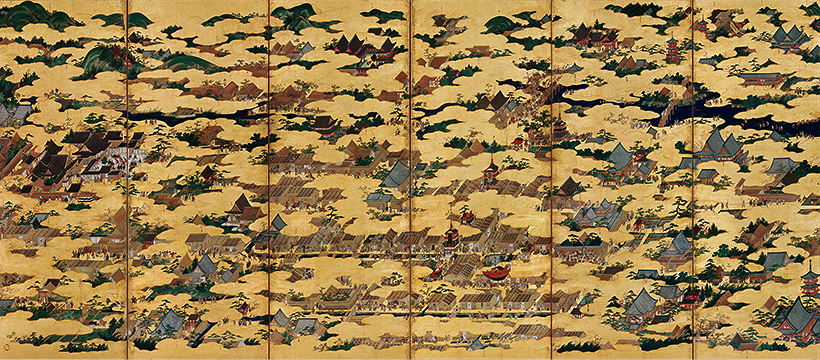 (rightl) (rightl)
Scenes in and around the Capital (Uesugi Version)
By Kanō Eitoku
Muromachi period, 1565
Yonezawa City Uesugi Museum, Yamagata
National Treasure
(On exhibit from October 6 to November 1, 2020)
|
Cypress
By Kanō Eitoku
Azuchi-Momoyama period, 1590
Tokyo National Museum
National Treasure
(On exhibit from October 6 to November 1, 2020)
|
Maple Trees
By Hasegawa Tōhaku
Azuchi-Momoyama period, Circa 1592
Chishakuin Temple, Kyoto
National Treasure
(On exhibit from October 6 to November 29, 2020)
|
です
A Century of Change: Muromachi to Edo
Here you can compare artworks created over the century between the late Muromachi period to the early Edo period. How did art change during that time? Whether portraits of or calligraphy by emperors Oda Nobunaga, Toyotomi Hideyoshi and Tokugawa Ieyasu; paintings on the same theme created across those periods, or myriad decorative artworks ranging from stationary boxes to tea ceremony kettles, mirrors, and even coins, this selection fully conveys how changing times brought about changing tastes, aesthetics and art.
|
|
|
Portrait of Ashikaga Yoshiteru
Painting attributed to Tosa Mitsuyoshi; Inscription by Sakugen Shūryō
Azuchi-Momoyama, 1577
National Museum of Japanese History
Important Cultural Property
(On exhibit from November 3 to November 29, 2020)
|
|
|
Sketch for a Portrait of Toyotomi Hideyoshi
Attributed to Kanō Mitsunobu
Azuchi-Momoyama period, 16th century
Itsuo Art Museum, Osaka
Important Cultural Property
(On exhibit from October 6 to November 29, 2020)
|
|
|
Momoyama Prelude: Warring States Aesthetics
The Muromachi period built the groundwork for what would become the glorious beauty and power of Momoyama culture. Lovely gold ground screens depicting the capital Kyoto and large format panel and wall paintings for Zen temples were art forms begun in the Muromachi period. And yet these works emphasized aesthetics that honored the pomp and ritual of ceremonies and events related to the emperor or shogun.
Later, the Ōnin War (1467-1477) and the Meiō Coup (1493) saw the leading culture of the day spread to regional daimyō and to townspeople throughout Japan. Their tastes added a new dimension to earlier art forms as they changed to those of the next era. This section confirms the classic aesthetics of the late Muromachi period and the as yet nascent buds of the Momoyama tastes that would follow.
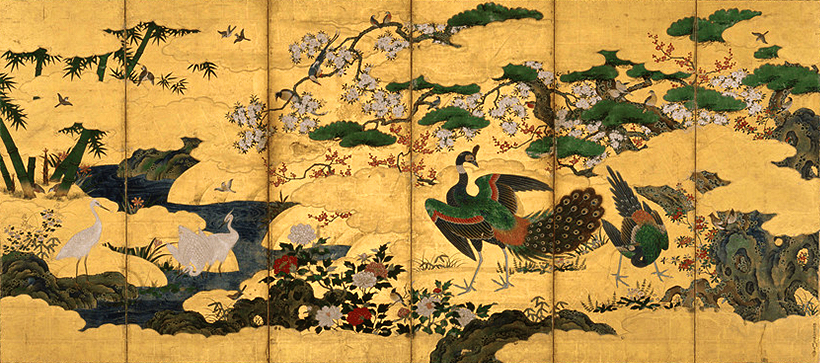 (right) (right)
Birds and Flowers of the Four Seasons
By Kanō Motonobu
Muromachi period, 1550 (Tenbun 19)
Hakutsuru Fine Art Museum, Hyōgo
Important Cultural Property
(On exhibit from November 10 to November 29, 2020)
|
Making Tea: Chanoyu from Rikyū to Oribe
As the Muromachi shogunate waned, townspeople emerged as the standard bearers of a new age. They studied renga linked verse and the noh theater, and built rustic hut-style buildings in the city where they could enjoy the tea ceremony within suitably wabi settings.
As part of this process Sen no Rikyū (1522–1591), tea master to the ruling generals of the day, created a new form of tea ceremony aesthetic. He turned everyday items into tea utensils and made his own utensils that spoke to him. He broke free from the emphasis on tea utensil provenance and style, instead giving form to tea as a sincere meeting of minds.
Rikyū’s aesthetic had a massive influence on later tea masters. The tea utensils made and used by one such master, Furuta Oribe (1544–1615), exude a powerful and overwhelming presence. Seemingly the direct opposite of his teacher Rikyū’s tastes, in fact, some aspects of Rikyū’s tastes can be found in Oribe’s strikingly chic tea style.
|
|
|
Ki-Seto Vase, known as Tabimakura
Mino ware
Azuchi-Momoyama period, 16th century
Kuboso Memorial Museum of Arts, Izumi, Osaka
Important Cultural Property
(On exhibit from October 27 to November 29, 2020)
|
Mature Momoyama: From Splendid to Stylish
The overwhelming painting style of Kanō Eitoku, the painter favored by Hideyoshi, was preferred by the Warring States generals and became the de facto painting style of the Azuchi-Momoyama period. His successors, however, distanced themselves from ostentatious displays of power, creating instead a world of beauty that emphasized refined elegance and natural harmony. This development also played out in calligraphy, from the uninhibited freedom of Konoe Nobutada to Hon’ami Kōetsu’s calligraphy brushed against a background of underpaintings by Tawaraya Sōtatsu. Ceramics too, there was a shift from accidental and powerful forms to more designed, stylized beauty.
This period also saw the birth of genre painting in Japan, taking the vivid lives of ordinary people, the strutting swagger of dandies as their theme. Carrying on elements from Momoyama arts, the art of the new Edo period had begun.
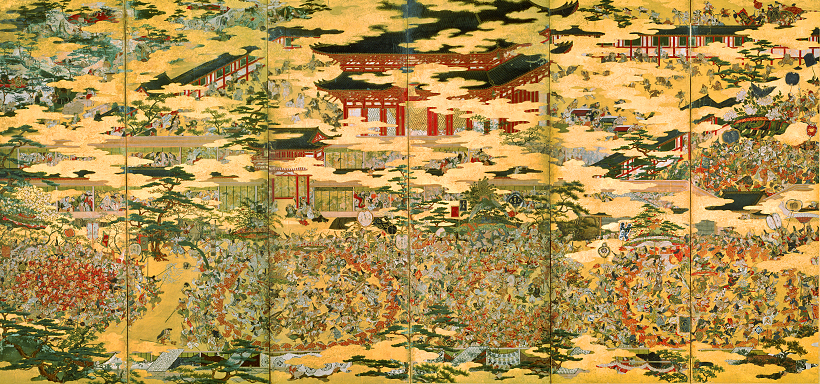 (left) (left)
Hōkoku Festival
By Iwasa Matabē
Edo period, 17th century
The Tokugawa Art Museum, Aichi
Important Cultural Property
(On exhibit from October 6 to October 25, 2020)
|
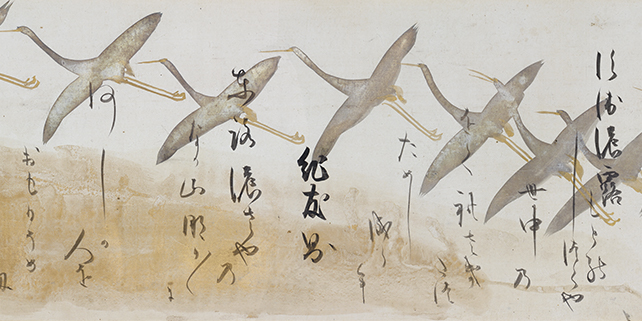 (detail) (detail)
Poems by the Thirty-Six Immortal Poets with Crane Underpainting
Calligraphy by Hon’ami Kōetsu; Painting by Tawaraya Sōtatsu
Edo period, 17th century
Kyoto National Museum
Important Cultural Property
(On exhibit from October 6 to November 1, 2020)
|
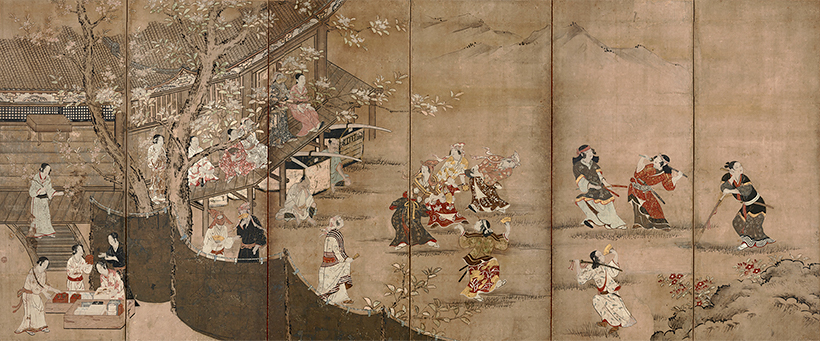 (detail) (detail)
Amusements under the Blossoms
By Kanō Naganobu
Edo period, 17th century
Tokyo National Museum
National Treasure
(On exhibit from October 6 to November 29, 2020)
|
Equipping a General: Arms and Armor
The Azuchi-Momoyama period was a harsh time of constant battles. To cope with the seemingly endless repetition of battles, a new type of armor was developed, the tōsei gusoku, a simplified structure that protected the entire body. A new type of sword mounting, the uchigatana, could be quickly drawn and cut, while long scabbards with swordguards bound on by cords were widely used. All of the armor and weapons used by the Azuchi-Momoyama period generals were further enhanced with decorations and special features, elements to display their rank and personal tastes. With the advent of the Edo period, these expressive means became symbols of military class status and privilege.
This section introduces the “life or death” equipment of generals, which cannot simply be thought of as lively tastes or novel designs.
|
|
Gusoku Type Armor with a European-Style Cuirass with Dark Blue Lacing
Azuchi-Momoyama–Edo period, 16th–17th century
Tokyo National Museum
Important Cultural Property
(On exhibit from October 6 to November 29, 2020)
|
|
|
|
|
|
Long Sword (Katana), with Katana Style Sword Mounting on Red Lacquer
Attributed to Bizen Motoshige
[Blade] Nanbokuchō period, 14th century
[Sword Mounting] Azuchi-Momoyama–Edo period, 16th–17th century
Tokyo National Museum
Important Cultural Property
(On exhibit from October 6 to November 29, 2020)
|
Towards Peace: Art for a New Shogunal Era
With Tokugawa Ieyasu’s defeat of the Toyotomi forces in the Osaka Summer Campaign, he declared a new reign name of Genna and the end of an era of war. The Edo shogunate headed by the Tokugawa family established a series of laws and edicts regulating the behavior of the military class families and thereby ushered in a new era of real peace in the land.
Nijō-jō Castle was the Tokugawa family residential castle in the city of Kyoto, and they adorned it with wall and panel paintings, adding a quiet sense of strict dignity to the magnificence of the Azuchi-Momoyama period. The provenance of tea utensils handed down from the powerful members of the Muromachi shogunate was revered and they became a status symbol of the new elite, while near godlike status was accorded to the items owned by the Edo shogunate’s founder Tokugawa Ieyasu.
This final section introduces the new social order created by the Edo shogunate at the end of this century of tumult.
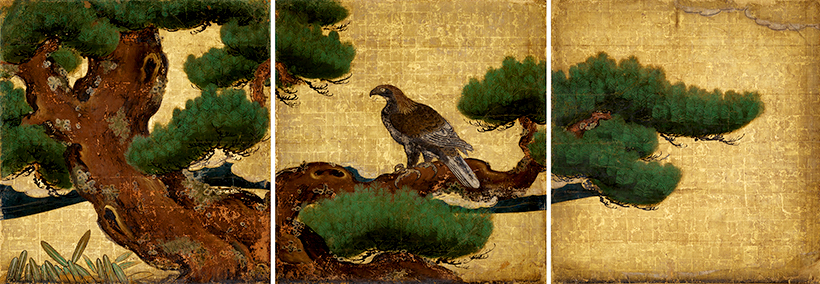 (detail) (detail)
Pine and Hawks Sliding Door Panels and Wall Paintings
By Kanō Sanraku
Edo period, 1626
Former Imperial Villa Nijō-jō Castle Office, Kyoto City, Kyoto
Important Cultural Property
(On exhibit from October 6 to November 29, 2020)
|
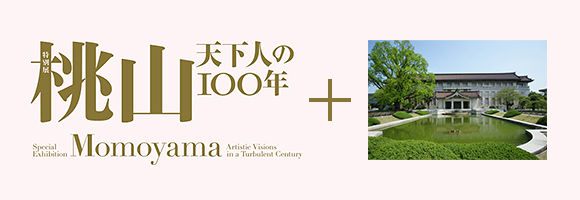
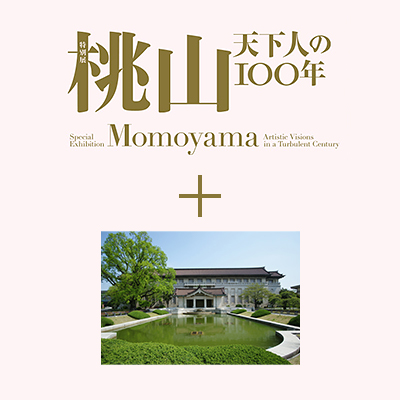 Momoyama
Momoyama![]() List of Works *Updated on 2020.10.26 (622KB)
List of Works *Updated on 2020.10.26 (622KB)![]()

